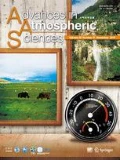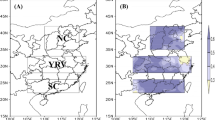Abstract
The summer of 2020 recorded a record-breaking flood due to excessive mei-yu rain falling over the Yangtze River Valley (YRV). Using the Lagrangian model FLEXPART, this paper investigates moisture sources and transport processes behind this extreme event. Based on climate data from 1979 to 2019, the air-particle (an infinitesimally small air parcel) trajectories reaching the YRV show sectors that correspond to five main moisture sources: the Indian monsoon region (IND, 27.5% of the total rainfall), the local evaporation (27.4%), the Western Pacific Ocean (WPO, 21.3%), the Eurasian continent (8.5%) and Northeast Asia (4.4%). In the 2020 mei-yu season, moisture from all source regions was above normal except that from Northeast Asia. A record-breaking moisture source from the IND and WPO dominated this extreme mei-yu flood in 2020, which was 1.5 and 1.6 times greater than the climate mean, respectively. This study reveals a significant relationship between the moisture source with three moisture transport processes, i.e., trajectory density, moisture content, and moisture uptake of air-particles. A broad anomalous anticyclonic circulation over the Indo-Northwestern Pacific (Indo-NWP) provides a favorable environment to enhance the moisture transport from the IND and WPO into the YRV. In the 2020 mei-yu season, a record-breaking Indo-NWP anomalous anticyclonic circulation contributed to a higher trajectory density as well as higher moisture content and moisture uptake of air-particles from the IND and WPO regions. This collectively resulted in unprecedented moisture transport from source origins, thus contributing to the mei-yu flood over the YRV in 2020.
摘要
2020 年夏季长江流域破纪录的梅雨降水造成了严重的洪涝灾害. 本研究利用拉格朗日模型 FLEXPART 开展水汽追踪, 分析了 2020 年洪涝的水汽来源及其过程. 结果显示梅雨期长江流域降水有五个主要水汽源地: 印度季风区 (对气候平均总降水贡献为 27.5%)、 当地蒸发 (27.4%)、 西太平洋 (21.3%)、 欧亚大陆 (8.5%) 和东北亚地区 (4.4%). 2020 年梅雨期间, 除东北亚地区外, 所有源地的水汽贡献均高于气候平均, 其中来自印度季风区和西太平洋地区的水汽源贡献均突破了 1979 年以来的历史记录, 分别达到了各自气候平均的 1.5 和 1.6 倍, 主导了 2020 年的极端梅雨降水. 本研究进一步分析了与水汽源地贡献有关的三个水汽输送物理量, 分别是追踪到的空气粒子的轨迹密度、 水汽含量和水汽摄取量, 揭示了它们与不同源区水汽贡献之间的显著关系. 研究指出, 2020 年梅雨期间, 破纪录的印度-西北太平洋反气旋环流异常, 使得来自印度季风区和西太平洋的水汽粒子轨迹密度更高, 水汽摄取量更多, 携带的水汽含量更高, 进而造成了两个地区在该年梅雨期破纪录的水汽贡献, 导致了 2020 年长江流域的梅雨洪水.
Similar content being viewed by others
References
Adler, R. F., and Coauthors, 2003: The version-2 global precipitation climatology project (GPCP) monthly precipitation analysis (1979-present). Journal of Hydrometeorology, 4(6), 1147–1167, https://doi.org/10.1175/1525-7541(2003)004<1147:TVGPCP>2.0.CO;2.
Alexander, M. A., J. D. Scott, D. Swales, M. Hughes, K. Mahoney, and C. A. Smith, 2015: Moisture pathways into the U.S. intermountain west associated with heavy winter precipitation events. Journal of Hydrometeorology, 16, 1184–1206, https://doi.org/10.1175/JHM-D-14-0139.1.
CMA, 2021: 2020 China climate bulletin. Available from http://www.cma.gov.cn/2011xwzx/2011xqxxw/2011xqxyw/202102/t20210209_571871.html. (in Chinese)
Ding, Y. H., Y. Y. Liu, and Z.-Z. Hu, 2021: The record-breaking Mei-yu in 2020 and associated atmospheric circulation and tropical SST anomalies. Adv. Atmos. Sci., in press, https://doi.org/10.1007/s00376-021-0361-2.
Gimeno, L., and Coauthors, 2012: Oceanic and terrestrial sources of continental precipitation. Rev. Geophys., 50, RG4003, https://doi.org/10.1029/2012RG000389.
Gimeno, L., and Coauthors, 2020: Recent progress on the sources of continental precipitation as revealed by moisture transport analysis. Earth-Science Reviews, 201, 103070, https://doi.org/10.1016/j.earscirev.2019.103070.
Guo, L., R. J. van der Ent, N. P. Klingaman, M.-E. Demory, P. L. Vidale, A. G. Turner, C. C. Stephan, and A. Chevuturi, 2019: Moisture sources for East Asian precipitation: Mean seasonal cycle and interannual variability. Journal of Hydrometeorology, 20, 657–672, https://doi.org/10.1175/JHM-D-18-0188.1.
Hersbach, H., and Coauthors, 2019: Global reanalysis: Goodbye ERA-Interim, hello ERA5. ECMWF Newsletter 159, 10 pp, https://doi.org/10.21957/vf291hehd7.
Hu, Q., D. B. Jiang, X. M. Lang, and S. B. Yao, 2021: Moisture sources of summer precipitation over eastern China during 1979–2009: A Lagrangian transient simulation. International Journal of Climatology, 41, 1162–1178, https://doi.org/10.1002/joc.6781.
Liu, Y. Y., and Y. H. Ding, 2020: Characteristics and possible causes for the extreme Meiyu in 2020. Meteorological Monthly, 46(11), 1393–1404, https://doi.org/10.7519/j.issn.1000-0526.2020.11.001. (in Chinese with English abstract)
Liu, Y. Y., Y. G. Wang, and Z. J. Ke, 2021: Characteristics and possible causes for the climate anomalies over China in summer 2020. Meteorological Monthly, 47(1), 117–126, https://doi.org/10.7519/j.issn.1000-0526.2021.01.011. (in Chinese with English abstract)
Numaguti, A., 1999: Origin and recycling processes of precipitating water over the Eurasian continent: Experiments using an atmospheric general circulation model. J. Geophys. Res., 104, 1957–1972, https://doi.org/10.1029/1998jd200026.
Peng, D. D., T. J. Zhou, and L. X. Zhang, 2020: Moisture sources associated with precipitation during dry and wet seasons over central Asia. J. Climate, 33(24), 10755–10771, https://doi.org/10.1175/JCLI-D-20-0029.1.
Saha, S., and Coauthors, 2014: The NCEP climate forecast system version 2. J. Climate, 27(6), 2185–2208, https://doi.org/10.1175/JCLI-D-12-00823.1.
Sampe, T., and S.-P. Xie, 2010: Large-scale dynamics of the Meiyu-Baiu rainband: Environmental forcing by the westerly jet. J. Climate, 23(1), 113–134, https://doi.org/10.1175/2009JCLI3128.1.
Sodemann, H., C. Schwierz, and H. Wernli, 2008: Interannual variability of Greenland winter precipitation sources: Lagrangian moisture diagnostic and North Atlantic Oscillation influence. J. Geophys. Res., 113(D3), D03107, https://doi.org/10.1029/2007JD008503.
Stohl, A., C. Forster, A. Frank, P. Seibert, and G. Wotawa, 2005: The Lagrangian particle dispersion model FLEXPART version 6.2. Atmospheric Chemistry and Physics, 5(9), 2461–2474, https://doi.org/10.5194/acp-5-2461-2005.
Takaya, Y., I. Ishikawa, C. Kobayashi, H. Endo, and T. Ose, 2020: Enhanced Meiyu — Baiu rainfall in early summer 2020: Aftermath of the 2019 super IOD event. Geophys. Res. Lett., 47, e2020GL090671, https://doi.org/10.1029/2020GL090671.
Trenberth, K. E., 1998: Atmospheric moisture residence times and cycling: Implications for rainfall rates and climate change. Climatic Change, 39(4), 667–694, https://doi.org/10.1023/A:1005319109110.
Wang, Y. G., D. J. Lou, and Y. Y. Liu, 2020: Characteristics and causes analysis of abnormal Meiyu rainfall in the middle and lower reaches of Yangtze River Valley in 2020. Torrential Rain and Disasters, 39(6), 549–554, https://doi.org/10.3969/j.issn.1004-9045.2020.06.001. (in Chinese with English abstract)
Wei, J. F., P. A. Dirmeyer, M. G. Bosilovich, and R. G. Wu, 2012: Water vapor sources for Yangtze River Valley rainfall: Climatology, variability, and implications for rainfall forecasting. J. Geophys. Res., 117, D05126, https://doi.org/10.1029/2011JD016902.
Wu, B., and T. J. Zhou, 2008: Oceanic origin of the interannual and interdecadal variability of the summertime western Pacific subtropical high. Geophys. Res. Lett., 35, L13701, https://doi.org/10.1029/2008GL034584.
Wu, B., T. J. Zhou, and T. Li, 2009a: Seasonally evolving dominant interannual variability modes of East Asian climate. J. Climate, 22, 2992–3005, https://doi.org/10.1175/2008JCLI2710.1.
Wu, B., T. J. Zhou, and T. Li., 2009b: Contrast of rainfall-SST relationships in the western North Pacific between the ENSO-developing and ENSO-decaying summers. J. Climate, 22, 4398–4405, https://doi.org/10.1175/2009JCLI2648.1.
Wu, B., T. Li, and T. J. Zhou, 2010: Relative contributions of the Indian Ocean and local SST anomalies to the maintenance of the western North Pacific anomalous anticyclone during the El Niño decaying summer. J. Climate, 23, 2974–2986, https://doi.org/10.1175/2010JCLI3300.1.
Xie, S.-P., K. M. Hu, J. Hafner, H. Tokinaga, Y. Du, G. Huang, and T. Sampe, 2009: Indian Ocean capacitor effect on Indo-Western Pacific climate during the summer following El Niño. J. Climate, 22, 730–747, https://doi.org/10.1175/2008JCLI2544.1.
Yang, J. L., Q. Y. Liu, S.-P. Xie, Z. Y. Liu, and L. X. Wu, 2007: Impact of the Indian Ocean SST basin mode on the Asian summer monsoon. Geophys. Res. Lett., 34, L02708, https://doi.org/10.1029/2006GL028571.
Zhong, L. H., L. J. Hua, Z. G. Ma, and Y. Yao, 2019: A quantitative study of moisture transport variation on the interdecadal variation of the summer precipitation in South China from 1979 to 2015. Climate Dyn., 53, 4743–4761, https://doi.org/10.1007/s00382-019-04822-0.
Zhou, T.-J., and R.-C. Yu, 2005: Atmospheric water vapor transport associated with typical anomalous summer rainfall patterns in China. J. Geophys. Res., 110, D08104, https://doi.org/10.1029/2004JD005413.
Zhou, Z.-Q., S.-P. Xie, and R. H. Zhang, 2021: Historic Yangtze flooding of 2020 tied to extreme Indian Ocean conditions. Proceedings of the National Academy of Sciences of the United States of America, 118(12), e2022255118, https://doi.org/10.1073/pnas.2022255118.
Acknowledgements
This paper was supported by the National Natural Science Foundation of China (Grant No. 42075037) and the Ministry of Science and Technology of China (Grant No. 2018YFA0606501), and the Program of International S&T Cooperation (Grant No. 2018YFE0196000).
Author information
Authors and Affiliations
Corresponding author
Additional information
Article Highlights
• Moisture source origins for mei-yu rainfall over the Yangtze River Valley were identified based on FLEXPART model.
• The 2020 YRV mei-yu flood was dominated by a record-breaking moisture source from the Indian monsoon region and Western Pacific Ocean.
• A record-breaking Indo-North Western Pacific anomalous anticyclone in 2020 modulated the moisture transport processes, which collectively contributed to the unprecedented moisture sources in 2020.
This paper is a contribution to the special issue on Summer 2020: Record Rainfall in Asia—Mechanisms, Predictability and Impacts.
Rights and permissions
About this article
Cite this article
Zhang, L., Zhao, D., Zhou, T. et al. Moisture Origins and Transport Processes for the 2020 Yangtze River Valley Record-Breaking Mei-yu Rainfall. Adv. Atmos. Sci. 38, 2125–2136 (2021). https://doi.org/10.1007/s00376-021-1097-8
Received:
Revised:
Accepted:
Published:
Issue Date:
DOI: https://doi.org/10.1007/s00376-021-1097-8




